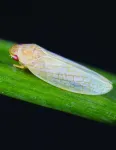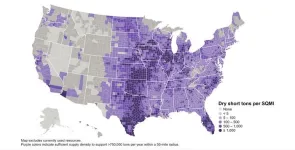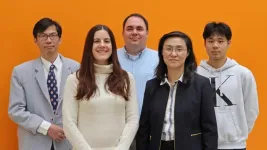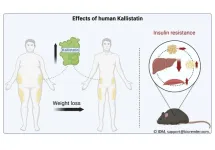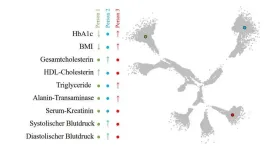(Press-News.org) UNIVERSITY PARK, Pa. — Leafhoppers, a common backyard insect, secrete and coat themselves in tiny mysterious particles that could provide both the inspiration and the instructions for next-generation technology, according to a new study led by Penn State researchers. In a first, the team precisely replicated the complex geometry of these particles, called brochosomes, and elucidated a better understanding of how they absorb both visible and ultraviolet light.
This could allow the development of bioinspired optical materials with possible applications ranging from invisible cloaking devices to coatings to more efficiently harvest solar energy, said Tak-Sing Wong, professor of mechanical engineering and biomedical engineering. Wong led the study, which was published today (March 18) in the Proceedings of the National Academy of Sciences of the United States of America (PNAS).
The unique, tiny particles have an unusual soccer ball-like geometry with cavities, and their exact purpose for the insects has been something of a mystery to scientists since the 1950s. In 2017, Wong led the Penn State research team that was the first to create a basic, synthetic version of brochosomes in an effort to better understand their function.
“This discovery could be very useful for technological innovation,” said Lin Wang, postdoctoral scholar in mechanical engineering and the lead author of the study. “With a new strategy to regulate light reflection on a surface, we might be able to hide the thermal signatures of humans or machines. Perhaps someday people could develop a thermal invisibility cloak based on the tricks used by leafhoppers. Our work shows how understanding nature can help us develop modern technologies.”
Wang went on to explain that even though scientists have known about brochosome particles for three-quarters of a century, making them in a lab has been a challenge due to the complexity of the particle’s geometry.
“It has been unclear why the leafhoppers produce particles with such complex structures,” Wang said, “We managed to make these brochosomes using a high-tech 3D-printing method in the lab. We found that these lab-made particles can reduce light reflection by up to 94%. This is a big discovery because it's the first time we've seen nature do something like this, where it controls light in such a specific way using hollow particles.”
Theories on why leafhoppers coat themselves with a brochosome armor have ranged from keeping them free of contaminants and water to a superhero-like invisibility cloak. However, a new understanding of their geometry raises a strong possibility that its main purpose could be the cloak to avoid predators, according to Tak-Sing Wong, professor of mechanical engineering and biomedical engineering and corresponding author of the study.
The researchers have found that the size of the holes in the brochosome that give it a hollow, soccer ball-like appearance is extremely important. The size is consistent across leafhopper species, no matter the size of the insect’s body. The brochosomes are roughly 600 nanometers in diameter — about half the size of a single bacterium — and the brochosome pores are around 200 nanometers.
“That makes us ask a question,” Wong said. “Why this consistency? What is the secret of having brochosomes of about 600 nanometers with about 200-nanometer pores? Does that serve some purpose?”
The researchers found the unique design of brochosomes serves a dual purpose — absorbing ultraviolet (UV) light, which reduces visibility to predators with UV vision, such as birds and reptiles, and scattering visible light, creating an anti-reflective shield against potential threats. The size of the holes is perfect for absorbing light at the ultraviolet frequency.
This potentially could lead to a variety of applications for humans using synthetic brochosomes, such as more efficient solar energy harvesting systems, coatings that protect pharmaceuticals from light-induced damage, advanced sunscreens for better skin protection against sun damage and even cloaking devices, researchers said. To test this, the team first had to make synthetic brochosomes, a major challenge in and of itself.
In their 2017 study, the researchers mimicked some features of brochosomes, particularly the dimples and their distribution, using synthetic materials. This allowed them to begin understanding the optical properties. However, they were only able to make something that looked like brochosomes, not an exact replica.
"This is the first time we are able to make the exact geometry of the natural brochosome,” Wong said, explaining that the researchers were able to create scaled synthetic replicas of the brochosome structures by using advanced 3D-printing technology.
They printed a scaled-up version that was 20,000 nanometers in size, or roughly one-fifth the diameter of a human hair. The researchers precisely replicated the shape and morphology, as well as the number and placement of pores using 3D printing, to produce still-small faux brochosomes that were large enough to characterize optically.
They used a Micro-Fourier transform infrared (FTIR) spectrometer to examine how the brochosomes interacted with infrared light of different wavelengths, helping the researchers understand how the structures manipulate the light.
Next, the researchers said they plan to improve the synthetic brochosome fabrication to enable production at a scale closer to the size of natural brochosomes. They will also explore additional applications for synthetic brochosomes, such as information encryption, where brochosome-like structures could be used as part of an encryption system where data is only visible under certain light wavelengths.
Wang noted that their brochosome work demonstrates the value of a biomimetic research approach, where scientists looks to nature for inspiration.
“Nature has been a good teacher for scientists to develop novel advanced materials,” Wang said. “In this study, we have just focused on one insect species, but there are many more amazing insects out there that are waiting for material scientists to study, and they may be able to help us solve various engineering problems. They are not just bugs; they are inspirations.”
Along with Wong and Wang from Penn State, other researchers on the study include Sheng Shen, professor of mechanical engineering, and Zhuo Li, doctoral candidate in mechanical engineering, both at Carnegie Mellon University, who contributed to the simulations in this study. Wang and Li contributed equally to this work, for which the researchers have filed a U.S. provisional patent. The Office of Naval Research supported this research.
END
Backyard insect inspires invisibility devices, next gen tech
2024-03-18
ELSE PRESS RELEASES FROM THIS DATE:
Americans support democratic norms, elected officials don't
2024-03-18
Following the attack on the U.S. Capitol on Jan. 6, 2021, and efforts to overturn the results of the 2020 presidential election, many Americans have raised concerns about the future of democracy in the United States.
Yet the American public, including Democrats and Republicans alike, strongly oppose anti-democratic actions and partisan violence, according to a new study by the Polarization Research Lab.
"Democracy is under threat in America, but these data show we are not on the brink of a citizen-supported push toward authoritarianism," says the lab's ...
Harnessing hydrogen at life’s origin
2024-03-18
A new report uncovers how hydrogen gas, the energy of the future, provided energy in the past, at the origin of life 4 billion years ago. Hydrogen gas is clean fuel. It burns with oxygen in the air to provide energy with no CO2. Hydrogen is a key to sustainable energy for the future. Though humans are just now coming to realize the benefits of hydrogen gas (H2 in chemical shorthand), microbes have known that H2 is good fuel for as long as there has been life on Earth. Hydrogen is ancient energy. The very first cells on Earth lived from H2 produced in hydrothermal vents, using the reaction of H2 with CO2 to make the molecules of ...
Sustainable biomass production capacity could triple US bioeconomy, report finds
2024-03-18
The United States could triple its current bioeconomy by producing more than 1 billion tons per year of plant-based biomass for renewable fuels, while meeting projected demands for food, feed, fiber, conventional forest products and exports, according to the Department of Energy’s latest Billion-Ton Report led by Oak Ridge National Laboratory.
The 2023 Billion-Ton Report, or BT23, announced by DOE, is the fourth in a series of national biomass resource assessments spanning two decades. The report identifies feedstocks that could be ...
Cure Mito Foundation and Hope for PDCD Foundation announce a patient registry collaboration
2024-03-18
March 18, 2024 – Cure Mito Foundation and Hope for PDCD foundation, both patient-led foundations focused on advancing research and supporting families affected by Leigh syndrome and Pyruvate Dehydrogenase Complex Deficiency (PDCD), respectively, are excited to announce a launch of a PDCD patient registry. This innovative registry will be led by the Hope for PDCD foundation and hosted on the same registry platform as the well-established Leigh Syndrome patient registry, developed by the Cure Mito Foundation. This strategic move is aimed at enhancing patient convenience and improving data alignment and research ...
Newborn piglets serve as a model for studying influenza
2024-03-18
Although prevention and treatment strategies are available for influenza, they are not sufficient for vulnerable populations such as young children and newborns. In a new study, published in Virology, a multidisciplinary team of researchers have studied newborn piglets to better understand the progression of influenza infections.
The influenza A virus can infect a variety of birds and mammals, including humans and pigs, due to which it is a threat to public health and food security. While it causes mild ...
Kallistatin contributes to the beneficial metabolic effects of weight loss
2024-03-18
After weight loss, people with overweight and obesity express more of the protein Kallistatin* in subcutaneous white adipose tissue. This was demonstrated by researchers from the DZD in a recent study. In addition, Kallistatin improves metabolism and could open up new therapeutic options for people with obesity and type 2 diabetes in future. The results have now been published in Molecular Metabolism.
An increasing number of people are developing type 2 diabetes and obesity. These are highly complex and multifaceted diseases. In order to treat them sustainably, new approaches to therapy are needed. Clinical studies on humans have ...
WashU engineers manage a first: measuring pH in cell condensates
2024-03-18
Scientists trying to understand the physical and chemical properties that govern biomolecular condensates now have a crucial way to measure pH and other emergent properties of these enigmatic, albeit important cellular compartments.
Condensates are communities of proteins and nucleic acids. They lack a membrane and come together and fall apart as needed. The nucleolus is a prominent condensate in cells. It serves vital roles in cellular physiology and is the site of ribosome production.
Ribosomes are the multi-protein ...
Study with innovative insights into the heterogeneity of type 2 diabetes
2024-03-18
A landmark study by the German Diabetes Center (DDZ), published in The Lancet Diabetes & Endocrinology, sheds new light on the heterogeneity of type 2 diabetes. The researchers employed an innovative algorithm to stratify people with type 2 diabetes using routine data and thus visualize the metabolic diversity of diabetes.
Type 2 diabetes is a disease with highly diverse progression pathways. Using an innovative algorithm, a team led by the German Diabetes Center (DDZ) used routinely measured variables to open up new perspectives on the diversity of type 2 diabetes in terms of insulin sensitivity, insulin secretion, ...
Breakthrough in melting point prediction: over 100-year-old physics problem solved by Queen Mary Professor
2024-03-18
A longstanding problem in physics has finally been cracked by Professor Kostya Trachenko of Queen Mary University of London's School of Physical and Chemical Sciences. His research, published in the Physical Review E, unveils a general theory for predicting melting points, a fundamental property whose understanding has baffled scientists for over a century.
For decades, our understanding of the three basic states of matter – solids, liquids, and gases – relied on temperature-pressure phase diagrams. These diagrams depict the conditions under which each state exists, with distinct lines separating them. However, one crucial line, ...
Shining a light on the underpinnings of rare disease impacting children
2024-03-18
A team from the University of Ottawa's Faculty of Medicine has completed an exciting new study that reveals the inner workings of gene mutations that result in an ultra-rare syndrome with fewer than 100 reported cases since its first description in the early 1960s.
The hard-won research discovery may accelerate the development of a treatment for Borjeson-Forssman-Lehmann Syndrome (BFLS), a neurodevelopmental disorder linked to the X chromosome that’s characterized by seizures, intellectual disability, and behavioural ...
